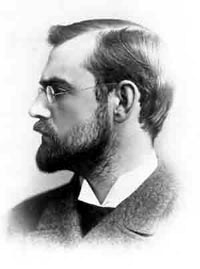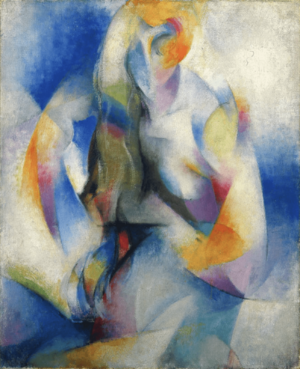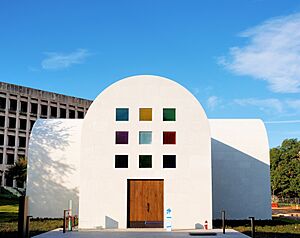Blanton Museum of Art facts for kids
 |
|
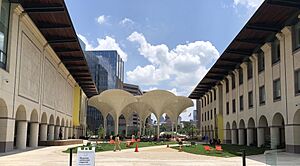 |
|
| Former name | University Art Museum; Archer M. Huntington Art Gallery |
|---|---|
| Established | 1963 |
| Location | Austin, Texas |
| Type | Art museum |
| Accreditation | American Alliance of Museums |
| Collections | Old Master paintings, prints, drawings, Minimalism, Post-minimalism, Conceptual art, Latin American art, Western American Art, Antiquities |
| Collection size | 21,000 objects |
| Visitors | 260,899 (2024) |
The Jack S. Blanton Museum of Art, often called the Blanton, is one of the biggest university art museums in the United States. It is located at the University of Texas at Austin. The museum has a huge space for art, including galleries for its permanent collection, special exhibitions, classrooms, and a shop.
The Blanton's collection has more than 21,000 artworks. It is especially known for its modern and contemporary art, Latin American art, and Old Master paintings. In 2024, the Washington Post newspaper named the Blanton one of the top five college art museums in the U.S. They praised its exciting programs and focus on learning.
Contents
History of the Blanton Museum
The Blanton Museum's story began in 1927. A kind person named Archer Milton Huntington, who loved learning, gave a large piece of land to the University of Texas at Austin. This land was meant to help create a museum. This gift became the Archer M. Huntington Museum Fund. Over many years, this fund helped the museum buy more than 1,400 artworks. These artworks range from very old Greek oil bottles to modern video art.
The Huntington Fund also helped build the Art Building. This building opened in 1963 and housed both the University's Art Department and the University Art Museum. In 1964, Donald Goodall became the museum's first director.
Over time, the museum's collection grew. Some parts of the collection were kept in different places. In 1979, the museum was renamed the Archer M. Huntington Art Gallery.
A big change happened in 1994 when Mari Yoriko Sabusawa gave $5 million. This gift was for a new museum building that would bring all the university's art collections together. The plan for a new building started in 1997 with a large gift from the Houston Endowment, Inc. This gift honored Jack S. Blanton. Because of this, the museum was renamed the Blanton Museum of Art. Construction on the new building began in 2003.
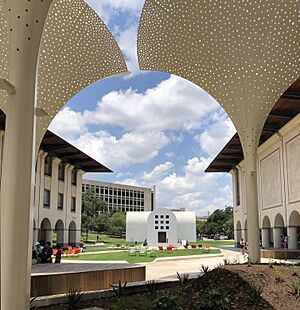
The new main gallery building, called the Mari and James A. Michener Gallery Building, opened in 2006. Another building for education and offices opened in 2008. Simone Wicha became the museum's director in 2011.
In 2015, a famous artist named Ellsworth Kelly gave the Blanton Museum a special design. It was for a stone building with colorful stained-glass windows. He named this building Austin. The museum worked hard to raise money to build it. Austin opened to the public on February 18, 2018.
In 2019, the Blanton received another big gift from The Moody Foundation. This gift helped fund a major redesign of the museum's outdoor areas. The redesign was led by the company Snøhetta. In May 2023, the museum showed off its "reimagined" outdoor grounds and plaza. New features include twelve tall, three-story "petals" that provide shade. There is also a large mural by Cuban-American artist Carmen Herrera called Verde, que te quiero verde.
Art Collections at the Blanton
The Blanton Museum has a permanent collection of over 21,000 artworks. It is well-known for its European paintings, prints, drawings, and modern art from America and Latin America.
Ancient Art and Plaster Casts
The Blanton has a collection of ancient Greek, Etruscan, and Roman vases. Some of these vases are from as far back as 600 BCE. Many came from a collection started by the 2nd Marquess of Northampton, who helped dig up ancient sites in Italy.
The museum also displays the Battle Collection of Plaster Casts. These are 86 plaster copies of ancient Greek and Roman sculptures. They were collected by William James Battle, a former professor at the University of Texas at Austin, between 1894 and 1923.
European Art Before 1900
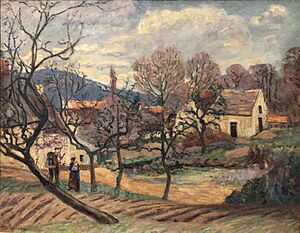
The Blanton's collection of European art from before 1900 includes paintings, sculptures, and decorative items. A very important part is the Suida-Manning Collection. This collection has over 650 works by artists from the 15th to 18th centuries. Famous artists in this collection include Parmigianino, Paolo Veronese, Tiepolo, and Rubens.
The museum also has 17th-century Dutch art and English portraits. These include works by Nicolaes Maes and famous portrait painters like Thomas Gainsborough and Thomas Lawrence.
A special painting, Environs de Paris (around 1890) by Armand Guillaumin, was given to the Blanton in 2004 by Lady Bird Johnson. It was the first Impressionist painting to join the museum's collection.
Modern and Contemporary Art
The Blanton has more than 4,000 modern and contemporary artworks. The novelist James Michener and his wife, Mari Yoriko Sabusawa, started giving their collection of 20th-century American paintings to the Blanton in the 1960s. They eventually donated over 300 works. They also gave money to help the museum buy about 100 more artworks.
The museum's collection includes works by important 20th-century artists like Thomas Hart Benton, Alice Neel, Jasper Johns, and Roy Lichenstein. The contemporary art collection features artists such as Yayoi Kusama, Glenn Ligon, and Tavares Strachan.
In 2009, an art installation called Stacked Waters by artist Teresita Fernández was added to the museum. In 2014, the Blanton also acquired important drawings, prints, and a major painting by the African-American artist Charles White.
Latin American Art
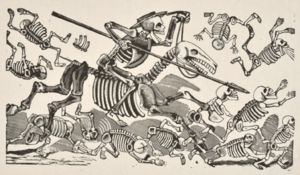
In 1959, Donald Goodall, the museum's first director, helped the Blanton get what was then the largest collection of Latin American art in the United States. The collection grew even more in the 1970s and 1980s with gifts from collector Barbara Duncan. The Blanton was the first museum in the U.S. to have a special expert (curator) for Latin American art in 1988.
A notable addition to the Latin American collection came in 2015 from collectors Judy and Charles Tate. This gift included 114 paintings, sculptures, and drawings by famous artists like Diego Rivera, José Clemente Orozco, Tarsila do Amaral, and Frida Kahlo.
The Blanton also has a collection of Christian religious art from Latin America, mostly from the 17th century onwards. These include statues, paintings, and metal works.
The Julia Matthews Wilkinson Center for Prints and Drawings
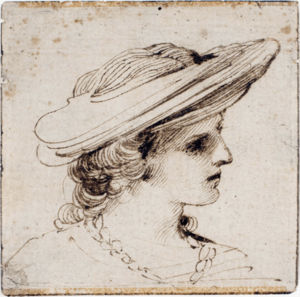
The Julia Matthews Wilkinson Center for Prints and Drawings is where most of the Blanton's 16,000 works on paper are kept. This center also has a special room for studying prints, a library, and offices for the art experts. The center focuses on three main areas: European art from 1450 to 1800, Latin American art after 1960, and American art of the 20th century.
The center's collection includes over 380 drawings from the Suida-Manning Collection, many of them Italian drawings from before 1800 by artists like Raphael and Guercino. It also has nearly 3,500 prints from the Leo Steinberg Collection, including early works by Hendrick Goltzius. The center's Latin American art collection includes thousands of works on paper from 18 different countries. About a quarter of the Blanton's works on paper are by American artists from 1900 onwards.
Western American Art
The Blanton's Western American art collection includes the C.R. Smith Collection. This collection has 91 artworks given to the Blanton between 1968 and 1988. It features works by artists like Albert Bierstadt, Maynard Dixon, and Thomas Moran.
Ellsworth Kelly's Austin
Austin is a special stone building designed by the artist Ellsworth Kelly. He gave the design to the Blanton Museum in 2015. This building is a work of art itself, similar to other famous artist-designed buildings like the Rothko Chapel. Kelly said he was inspired by old Romanesque and Byzantine art he saw in Paris. The museum raised $23 million to build Austin, which opened on February 18, 2018.
SoundSpace Performances
SoundSpace is a unique performance series that happens at the Blanton three times a year. It features different types of performances happening at the same time throughout the museum. This series has won awards and has featured artists like Graham Reynolds and Adrian Quesada.


